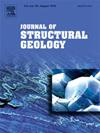从深度到地表的断层构造制图:亚平宁低应变地区微震活动与构造地质的整合
IF 2.9
2区 地球科学
Q2 GEOSCIENCES, MULTIDISCIPLINARY
引用次数: 0
摘要
高分辨率微地震数据提供了一个强大的窗口,从深度到地表,在缓慢变形的地区,稀疏的仪器地震活动。我们将来自增强目录的微地震集群与详细的结构测绘相结合,重建了意大利中部Latium-Abruzzi地区发震伸展断层的三维几何形状。所调查的地震群在几何上和运动学上与已知的和新测绘的正断层对齐,显示出晚第四纪活动的证据。三维模型描绘了一组sw - ssw倾斜的非平面断层,平均倾角为~ 55°(Sora, San Donato Val di Comino, Villavallelonga和Pescasseroli)。它们的截止深度向北北东方向加深,从~ 7到~ 14 km,表明下伏的基底不连续倾斜~ 30-35°。这些断层根部的微震斑块大多沿倾角而不是沿走向拉长。这种不寻常的几何形状表明应力释放模式是由等向各向异性粗糙度和基底不连续上的波纹控制的,这可能集中了向上的流体迁移并引发沿上壁面的地震。应力反演揭示了一个持续的NE-SW张性应力场,与地质和仪器时间尺度一致。考虑到标度定律的认知不确定性和断层表面的面积变异性,经验震级-面积关系得出的最大震级在6.0 - 6.5之间,与区域地震构造格局一致。这些发现为断层连通性、应力分布和流体-断层相互作用提供了新的约束条件,并有助于识别在单独考虑地质和地震数据时可能无法识别的潜在发震源。本文章由计算机程序翻译,如有差异,请以英文原文为准。
Mapping fault architecture from depth to surface: integrating microseismicity and structural geology in low-strain Apennine regions
High-resolution microearthquake data provide a powerful window into active fault architecture from depth to surface in slowly deforming regions with sparse instrumental seismicity. We integrate microseismic clusters from enhanced catalogs with detailed structural mapping to reconstruct the 3D geometry of seismogenic extensional faults in the Latium-Abruzzi sector of central Italy. Investigated earthquake clusters align geometrically and kinematically with known and newly mapped normal faults showing evidence of Late Quaternary activity. The 3D model depicts a set of SW-to-SSW-dipping, non-planar faults with an average dip of ∼55° (Sora, San Donato Val di Comino, Villavallelonga, and Pescasseroli). Their cut-off depths deepen NNE-ward, from ∼7 to ∼14 km, suggesting an underlying basal discontinuity dipping∼30–35°. Microseismic patches at the roots of these faults are mostly elongated along dip rather than along strike. This unusual geometry suggests a stress release pattern governed by iso-oriented anisotropic roughness and corrugations on the basal discontinuity, which may focus upward fluid migration and trigger earthquakes along hangingwall splays. Stress inversion reveals a persistent NE–SW tensional stress field consistent across geological and instrumental timescales. An empirical magnitude-area relationship, accounting for both epistemic uncertainty in scaling laws and areal variability of fault surfaces, yields maximum magnitudes between 6.0 and 6.5, consistent with the regional seismotectonic framework. These findings provide new constraints on fault connectivity, stress distribution, and fluid-fault interactions, and help identifying potentially seismogenic sources that may remain unrecognized when geological and seismic data are considered separately.
求助全文
通过发布文献求助,成功后即可免费获取论文全文。
去求助
来源期刊

Journal of Structural Geology
地学-地球科学综合
CiteScore
6.00
自引率
19.40%
发文量
192
审稿时长
15.7 weeks
期刊介绍:
The Journal of Structural Geology publishes process-oriented investigations about structural geology using appropriate combinations of analog and digital field data, seismic reflection data, satellite-derived data, geometric analysis, kinematic analysis, laboratory experiments, computer visualizations, and analogue or numerical modelling on all scales. Contributions are encouraged to draw perspectives from rheology, rock mechanics, geophysics,metamorphism, sedimentology, petroleum geology, economic geology, geodynamics, planetary geology, tectonics and neotectonics to provide a more powerful understanding of deformation processes and systems. Given the visual nature of the discipline, supplementary materials that portray the data and analysis in 3-D or quasi 3-D manners, including the use of videos, and/or graphical abstracts can significantly strengthen the impact of contributions.
 求助内容:
求助内容: 应助结果提醒方式:
应助结果提醒方式:


